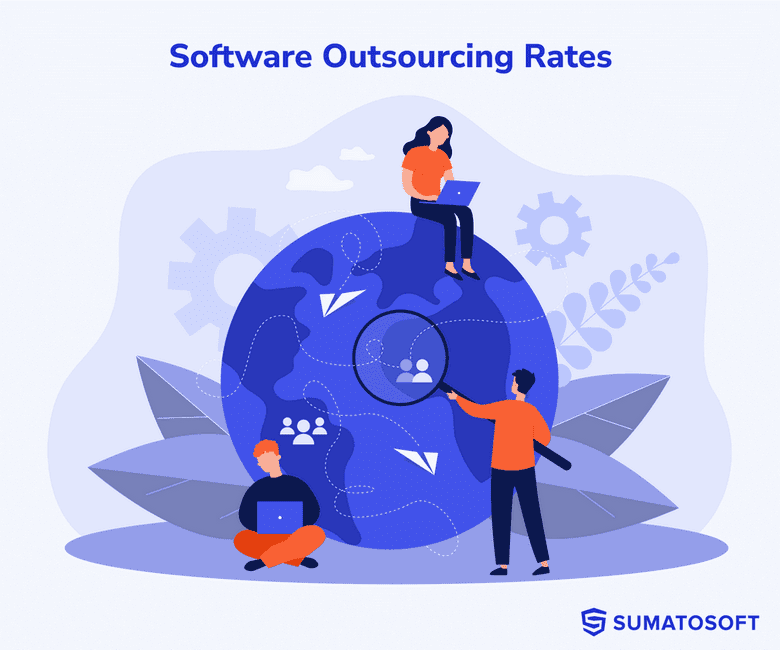How to Develop Agile MVP: Synergy, Process, Benefits, Examples


Agile, MVP– these terms are widespread in the software development industry and beyond. However, it became very apparent that there is a lot of confusion in the community on what is an MVP.
In the article, we explain Agile philosophy, describe the Agile MVP concept, provide MVP definition, tell how to build it, and give several great examples of MVP.
Enjoy reading!
Scrum is an Agile methodology
What Is Agile Methodology
Agile is a project management philosophy for software development with 4 core values and 12 principles that are cemented in the document “Manifesto for Agile Software Development” which was written by 14 CEOs, founders, and engineers in 2001. It features an interactive approach to software development and its delivery to end-users. This approach benefits from incremental improvements of the software product when portions of the system are developed and delivered to final users at different times rather than building a final product with all possible features before its big release.
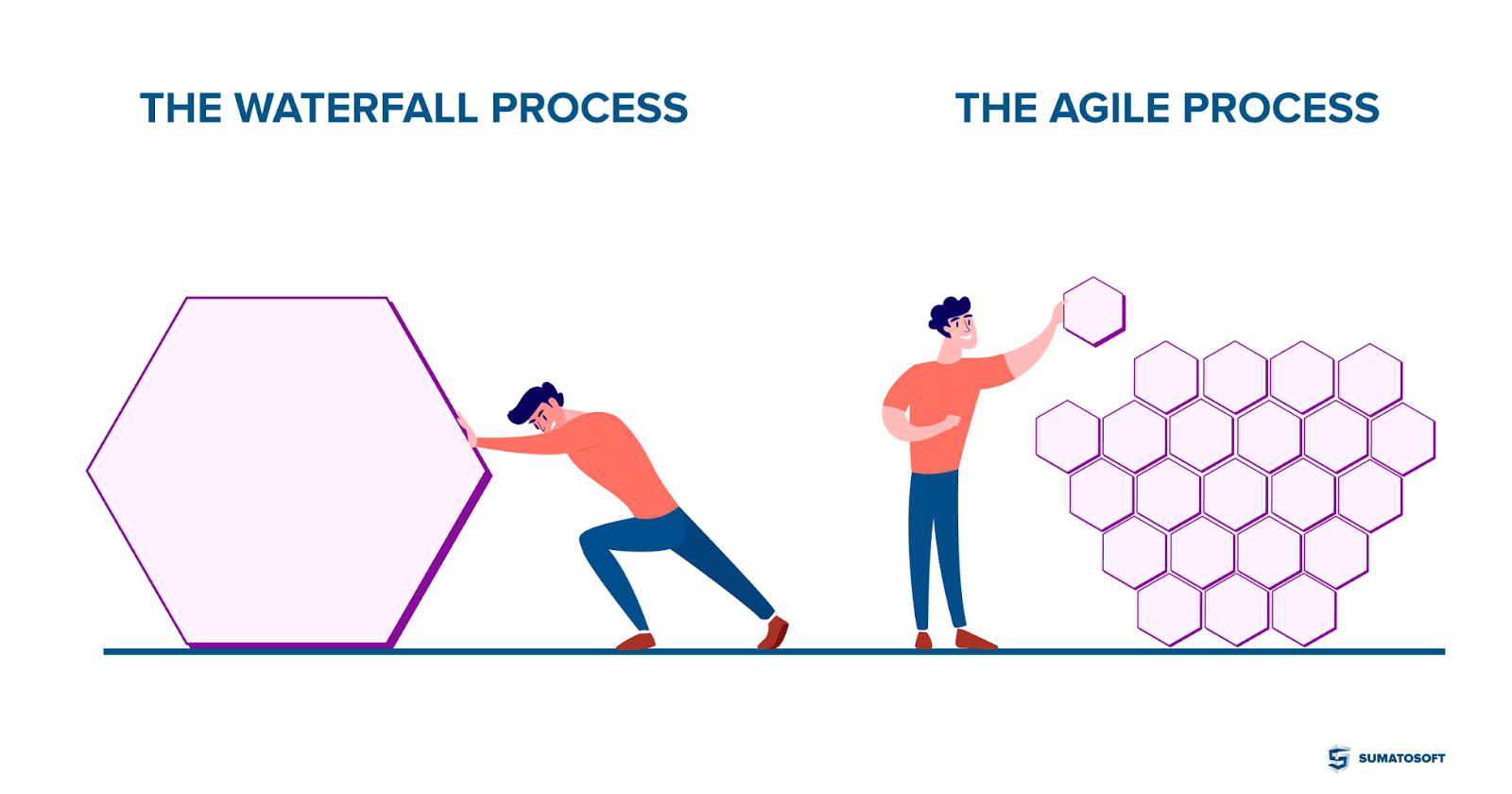
People came up with additional project delivery frameworks, practices, and methodologies based on the Agile philosophy. We can name some of them:
- Scrum;
- Lean software development;
- Extreme Programming;
- Feature-driven development.
The MVP term quite often walks beside the Agile methodology. However, the minimum viable product definition could be extremely vague and confusing. We want to clarify what does mvp mean in software development.
MVP in Agile Software Development
Minimum viable product (MVP) is the version of the software product with functionality that is enough to satisfy the user’s needs.
The concept was introduced in 2001 along with the Agile Manifesto publication, but it found the second wind as a part of the lean software development framework in 2009 after Eric Ries published his book “Lean Startup”. Eric Ries stated that by using agile MVP, you can collect validated learnings from customers:
The development of a new app starts when a team has guessed that their future product will be useful for users. However, they don’t know it for sure. A tricky thing lies here: the team can release an app with a tremendous amount of features, two-way integrations, and cool design to discover that the market doesn’t need this awesome product.
Another way is to develop an MVP and gather customers’ reviews after using the app. That approach helps the team to build a complete set of features that will be relevant to users.
Sounds impressive, right? Let’s move on.
There is a concept of “increment” which is a part of the Scrum methodology. It’s often confused with Agile MVP, so further understanding of the topic requires clarification of these two terms.
The Difference Between MVP and Increment
Let’s put everything on the table from the first lines. Ready?
An increment is fully described in the Scrum guide, while MVP was introduced as a part of the lean development approach. The Scrum guide mentions neither MVP nor lean development approach nor similar phrases.
The increment is a concrete stepping stone (usually software or some features) toward the product goal (usually a working product with some set of features). The increment must be done (which means there are no dependencies with non-developed functions), usable (bring value to users) and the responsible person may choose to immediately release it to get early feedback.
MVP, in turn, is software with a certain pack of working features that is enough to bring value to users so it can go public to gather early feedback from users.
These two definitions look similar, but in real projects, developers usually release several increments before calling it an MVP in Scrum. It can happen after one increment (rare case) or it could take many.
- Can MVP in Scrum consist of one increment? Yes.
- Is one increment equal to an MVP in Scrum? No.
Hope we managed to clarify the difference. Now, let’s focus solely on Agile MVP.
Why Build Agile MVP [6 Benefits]
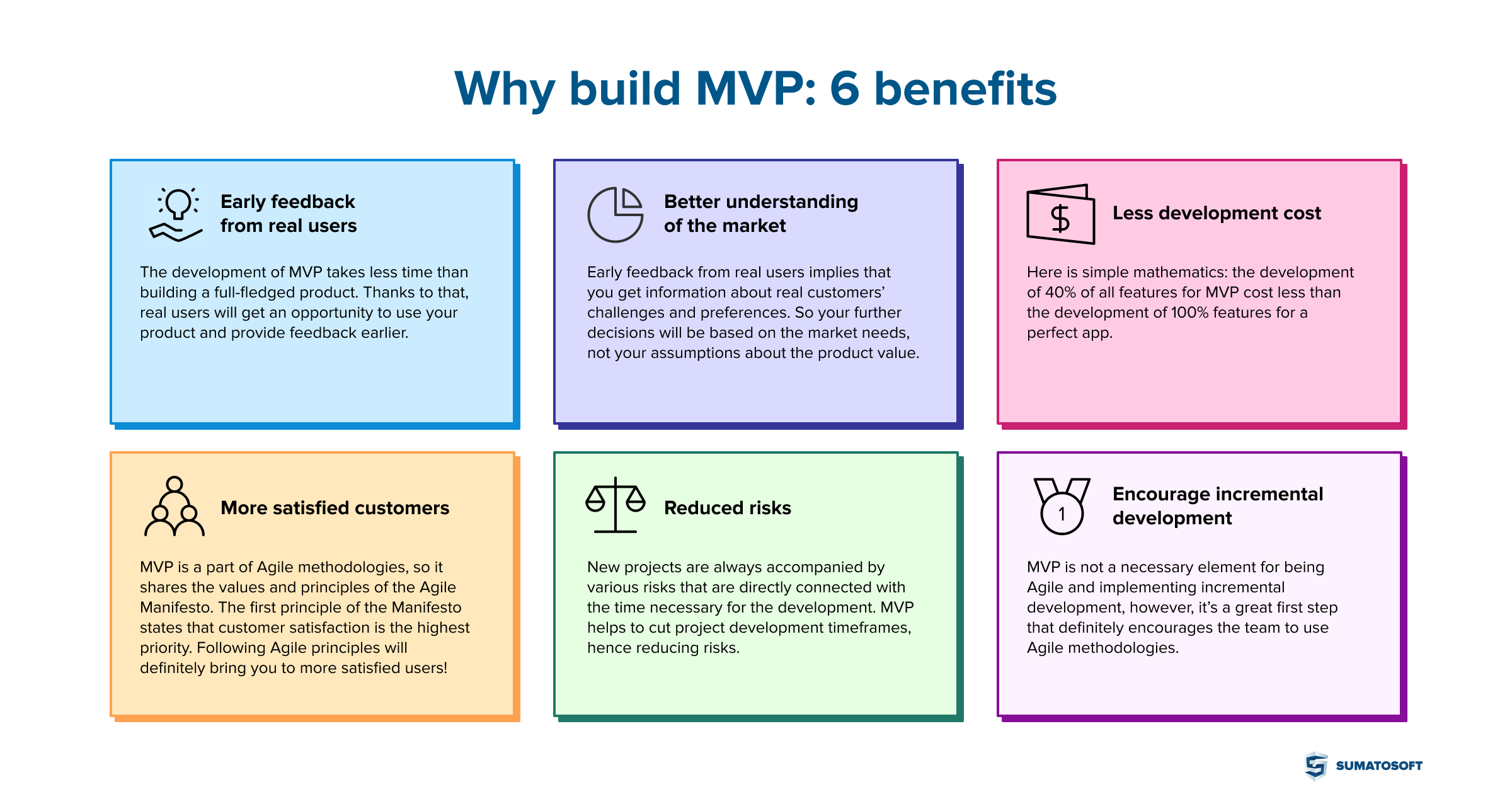
So, we explained what is a minimum viable product. The benefits MVP brings are numerous. We want to mention the major:
#1 Benefit: Early Feedback From Real Users
The minimum viable product software development takes less time than building a full-fledged product. Thanks to that, real users will get an opportunity to use your product and provide feedback earlier.
#2 Benefit: Better Understanding of the Market
Early feedback from real users implies that you get information about real customers’ challenges and preferences. So your further decisions will be based on the market needs, not your assumptions about the product value.
#3 Benefit: Less Development Cost
Here is simple mathematics: the development of 40% of all features for MVP costs less than the development of 100% of features for a perfect app.
#4 Benefit: More Satisfied Customers
MVP is a part of Agile methodologies, so it shares the values and principles of the Agile Manifesto. The first principle of the Manifesto states that customer satisfaction is the highest priority. Following Agile principles will definitely bring you more satisfied users!
#5 Benefit: Reduced Risks
New projects are always accompanied by various risks that are directly connected with the time necessary for the development. MVP helps to cut project development timeframes, hence reducing risks. Some of them are listed below:
- failure to meet deadlines of a too-big project;
- vague budget limitations, so you risk spending more money than was expected at the beginning;
- focusing on wrong user needs during the development leads to the risk of getting unsatisfied results because users wouldn’t buy the product as expected;
- the risk of making wrong decisions because of wrong assumptions about the customers without real feedback from them;
- the risk of wasting budget and time on the development in case of total product failure on the market.
#6 Benefit: Encourage Incremental Development
MVP is not a necessary element for being Agile and implementing incremental development. However, it’s a great first step that definitely encourages the team to use Agile methodologies.
How to Build Agile MVP
Building an Agile MVP involves a series of iterative steps. Here’s a concise overview:
- Identify and understand your target market. Before anything else, define who your product is for and understand their needs, challenges, and expectations. This ensures the MVP is relevant and valuable to your target audience.
- Define the value proposition. Clearly articulate the core benefit or problem that your product addresses. This helps in focusing the MVP on delivering real value to your customers.
- Select key features. Identify and prioritize a list of features based on their importance to your value proposition and the feedback from your target market. Focus on the essential features that solve the core problem.
- Design and develop the MVP. Start the development process with the selected key features. Agile methodology encourages rapid and iterative development, so design and build your MVP in sprints, allowing for quick adjustments based on feedback.
- Test with real users. Release the MVP to a small, controlled group of your target market. Observe how they use the product, gather feedback, and identify any issues or areas for improvement.
- Analyze feedback and iterate. Evaluate the feedback from your initial users critically. Identify patterns or common themes to understand what works well and what doesn’t. Use this insight to make informed decisions about future iterations.
- Plan for iteration. Based on the feedback, prioritize new features or improvements and plan your next development sprint. The agile approach is all about continuous improvement, so this step is crucial for evolving your MVP into a fully-fledged product.
- Repeat steps 5-7. Continue testing, gathering feedback, and iterating. Each cycle should aim to improve the product and bring it closer to what your target market needs and values.
It’s important to emphasize that Agile minimum viable product software development is not a linear process; it’s cyclical and iterative, focusing on learning and adapting. The steps outlined above should not be seen as a one-time progression but as a loop that repeats, with each iteration refining and improving the product based on real user feedback and changing market conditions.
To know more about evert step details, we offer you to read our other article about MVP development steps or refer to the most comprehensive guide from Google.
Common Mistakes in the Agile MVP Development
Still, the Agile MVP concept is not a panacea. It is an instrument that should be used correctly and only when necessary. Pushing MVP into every project without clarity in reasons is not a good idea. Unfortunately, sometimes people tend to leverage technologies and concepts when they hardly get the hang of them.
#1 Mistake: Believe that “Minimum” Means “Poorly Developed”
Sometimes, companies try to benefit from fast product delivery and disregard the idea that the product should be viable. Incomplete or untested products appear because of that confusion. How to avoid that mistake: MVP website development is not equal to a poorly developed product – all features in MVP should perform smoothly and well.
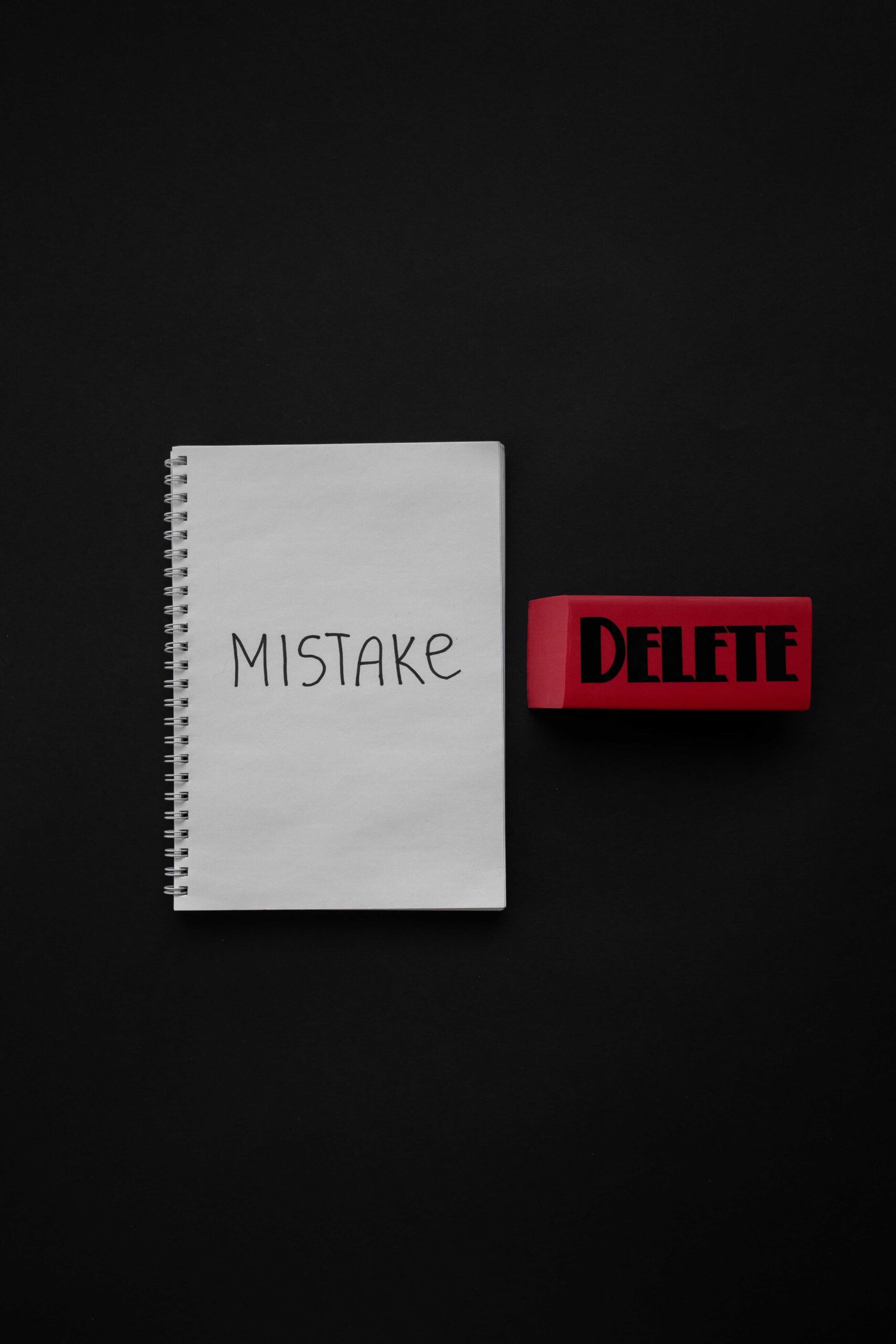
#2 Mistake: Overbuilding an MVP
MVP is neither the product with the least functionality nor the final full-fledged product. It’s challenging to understand where the right number of features for MVP is. The minimum becomes close to the maximum, and MVP website development becomes a subject of dispute between leaders who insist on including more functionality in MVP and developers who try to lessen the scope of work.
How to avoid that mistake: strictly define the functionality MVP should possess and assign a role that will be responsible for that list reconsideration.
#3 Mistake: No Idea How to Sell the Product
Without a clear vision, clearly defined user values, and well-developed features, people will not pay attention to the new product or buy it. The market is saturated with products – winning the hearts of new users is a task to be done.
How to avoid that mistake: explore ways to message your core offer to final users.
#4 Mistake: A Poorly Developed Feedback System
Early feedback is the reason developers should tap into building MVP. However, data collection will suffer if there is no good in-build feedback system in place.
How to avoid that mistake: build a good feedback system. The system may be embedded in the marketplace or directly in your app – it’s up to you.
There exists an intriguing approach that demands even less effort than Agile minimum viable product software development, as this method does not involve any product development—whether full-fledged, minimal, or viable.
MVP Without a Product – Reality or Nonsense?
Let’s start with examples:
If a company makes a video about the product when it doesn’t exist in the real world, is it an MVP?
If someone makes a product post on a crowdfunding platform without a real product and raises money to build it, is it an MVP?
If a game development company decides to develop a new game and makes a website with a fake demo video of the gameplay when the game development hasn’t been started yet, is it an MVP website development?
The answer to all questions is no.
In all cases above, we speak about pretotyping.
Pretotyping comes even before prototyping the app. It is the easiest way to test an app idea quickly and inexpensively by creating a virtual image of the app in the form of a video, a post on marketplaces, or a website. The aim is to demonstrate the product to final users and validate its product-market fit before the project development actually starts. If a huge number of users wish to buy the app it means you should develop it.
Pretotyping can be simply explained with the next scheme: if you buy it, we will build it.
Finally, we want to demonstrate two great examples of MVP:
Great Agile MVP Examples
Spotify: Listening Is Everything

Spotify app, the biggest audio streaming platform with over 381 million monthly active users, wasn’t even released to the public when it was developed!
The MVP had 3 core guesses: people want to listen to the music without storing it on the local drive, musicians and studios are ready to allow doing it legally, and the internet connection can provide sufficient bandwidth without lags and delays in listening. Based on that, developers built a music player with only one option: finding and playing a few hard-coded songs. The early adopters of that MVP were the developers themselves, their families, and friends.
Minecraft: a Sandbox Video Game
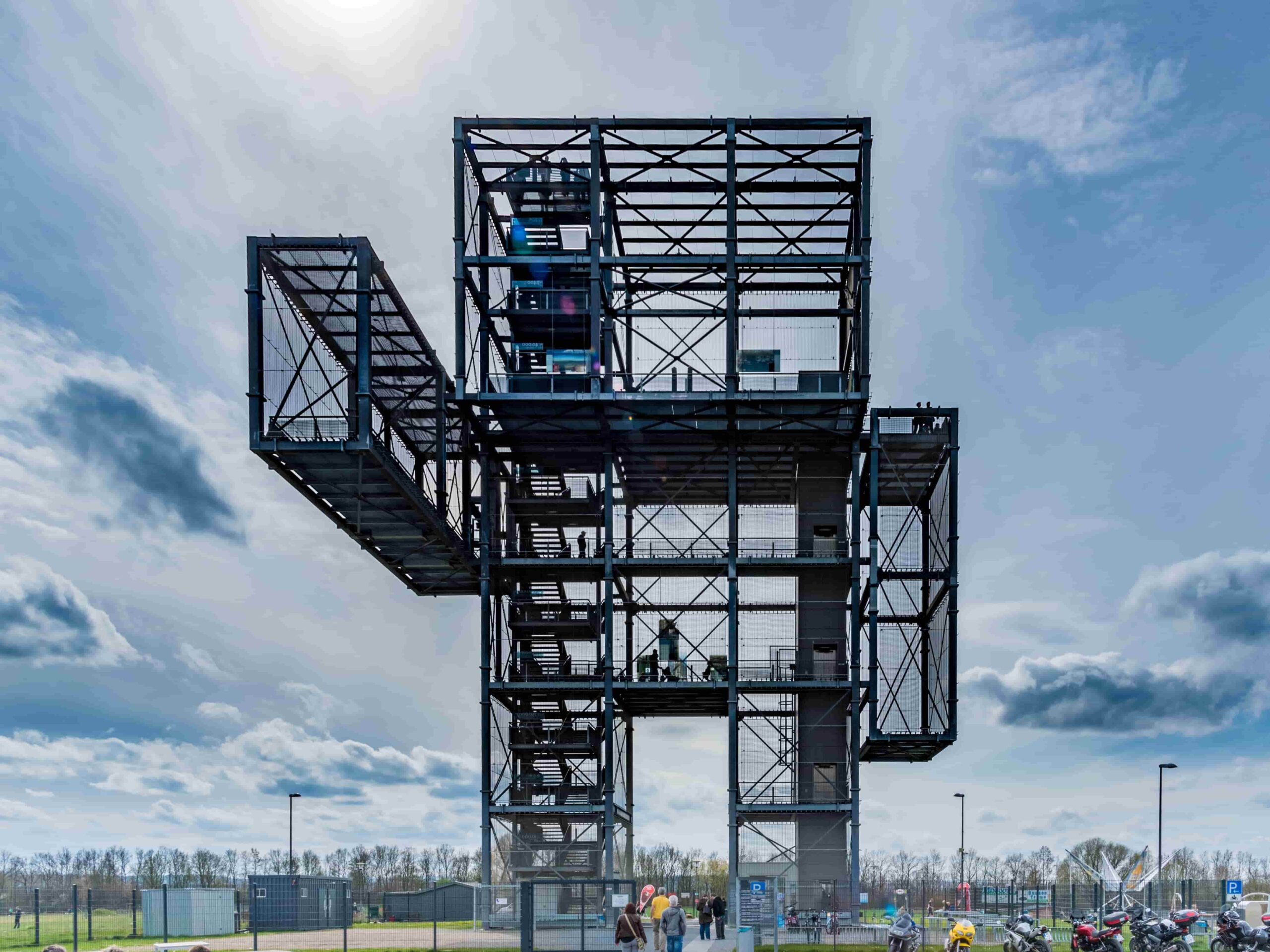
Minecraft, the best-selling video game of all time, allows users to gather natural resources, craft a wide variety of items, explore dungeons, defeat monsters, and even reconstruct the terrain and buildings from The Lord of the Rings universe.
This game, with tremendous opportunities, started as an ugly blocky 3D landscape where players can smash blocks and move them. The development time of that version took 6 days of coding by one guy:)
Large Agile MVP examples are rare; however, there are plenty of smaller projects where developers successfully implemented MVP. You can become the next example, and we can help to turn it into life.
Conclusion
We described what does MVP mean and how to build it, along with its benefits to businesses.
The Agile MVP approach offers a practical and efficient pathway for developing software products. By embracing the core principles of Agile methodology and focusing on delivering a Minimum Viable Product, teams can ensure they are building a product that truly meets user needs while minimizing waste and optimizing resources.
Thanks for reading!
SumatoSoft
This article was written with great expertise in the topic of writing since the SumatoSoft company provides software development services for startups, medium-sized businesses, and world-known brands, such as Toyota & Lexus, Beiersdorf to build their software products. We will be glad to help you in developing an MVP. Contact us to get a free quote!
Let’s start
If you have any questions, email us info@sumatosoft.com

